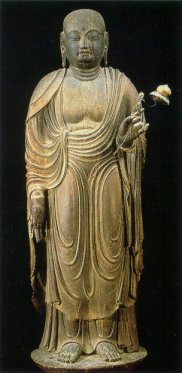| Contents
63. Fa Hsiang Sect (III)
63. Fa Hsiang
Sect (III)
63.1 Four
Functional Portions
With respect to the relationship between the subjective consciousness
and the object phenomena, there are four mental functional portions
in each of the eight consciousnesses. They are interdependent in
nature.
- The objective or the seen portion [相分],
ie. Laksana-bhaga -- all phenomena presented and revealed in mind.
The seen portions of the first five mental faculties (eye, ear,
nose, tongue and body) are the five 'dusts' (form, sound, smell,
taste and touch). The seen portion of the Manas consciousness
is the seeing portion of the Alaya consciousness, while the seen
portion of the Alaya consciousness is the seed of all mental faculties
and all matters and phenomena.
- The subjective or the seeing portion [見分],
ie. Darsana-bhaga -- the illumining or seeing effect of the 'dust',
which is transformed to its seen portion.
- The self-realizing or the self-assuring portion [自証分]
-- the portion that knows the seeing portion has seen the 'dusts'.
This function of cognition is called 'self-realization', or 'self-assurance'
or 'self-certification', without which no knowledge can be attained.
- The re-assuring portion [証自証分]
-- the portion that realizes the third portion upon internal reflection.
It concludes all the effects taken from the mental faculties.
For example, a piece of paper presented in mind is the seen portion,
while the seeing portion is the measuring instrument to see its
length and width. The self-assuring portion cognizes how long and
how wide it is, according to the measurements. The re-assuring portion
recognizes the accuracy of the measurements.

63.2 Five
Categories of Dharmas [五法]
In Lankavatara Sutra, all Dharmas are classified into five categories:
- Form [相] -- all matters, whether
sentient or non-sentient, has different forms, shapes, states,
marks, or the like.
- Name [名] -- A name is given to
each Dharma in accordance with its form, functions, characteristic,
etc
- Differentiation [分別] -- The relative
standard for big or small, good or bad, etc. is established for
our reference, differentiation, and recognition.
- Right Wisdom [正智] -- It refers
to the wisdom of the mental functions with non-outflow mind/consciousness
[無漏心]. All false forms and names
of Dharmas are regarded as provisional and impermanent. It is
also the wisdom that contemplates the ultimate truth -- Middle
Path.
- Thusness [如如] -- the state of
mind attained by Right Wisdom. As the mind is in the state of
Nirvana, not even one single Dharma is attained. This is so called
Thusness, which is the true nature of Dharma, the true noumenon,
or the Absolute.
The first three are Conditioned Dharmas [有為法],
while the last two are Unconditioned Dharmas [無為法].
63.3 The
Threefold Nature of Dharmas [三性]
The threefold nature of Dharmas are as follows:
- Dharma of sole imagination (Parikalpita-laksana in Sanskrit)
[偏計執性] -- just like to see the
shadow of a flax rope, and falsely believe it to be a snake. All
Dharmas regarding good and evil, existence and emptiness, happiness
and suffering, etc. have such characteristics.
- Dharma of dependence upon others (Paratanra-laksana in Sanskrit)
[依他起性] -- just like to see the
flax rope, but understand it is just a name given to the thing
that it serves the function of a 'rope'. When the flax is used
to make other thing, another name is given. A flax rope exists
only in causal combination or under the designated conditions.
It has no self-nature in existence, as it is not permanent and
depends on other factors.
- Dharma of ultimate and perfect reality (Parinispanna-laksana
in Sanskrit) [圓成實性] -- just like
a flax rope. Flax is the raw material of the rope, so the nature
of the rope is actually flax. Whatever you make with flax, the
nature of the thing remains unchanged -- it is the flax. It is
the substratum (so to speak) of all, and regarded as the real
nature of Dharma, which is unconditioned.
63.4 Five
Kinds of Dharmas [五位]
According to the doctrines of Fa-hsiang sect, there are five kinds
of Dharmas, which is further subdivided into one hundred Dharmas.
The five kinds are:
- Mind/Consciousness (Citta/Vijnana in Sanskrit) [心法]
-- 8 Dharmas
- Concomitant Mental Faculties (Caitasika or Citta-samprayukta-sanskara
in Sanskrit) [心所法] -- 51 Dharmas
- Form (Rupa in Sanskrit) [色法] --
11 Dharmas
- Dharmas neither form nor mental functions (Citta-viprayukta-sanskara
in Sanskrit) [心不相應法] -- 24 Dharmas
- Unconditioned Dharmas (Asamkrta) [無為法]
- 6 Dharmas
The first four are Conditioned Dharmas, while the last one is Unconditioned
Dharma.
63.5 One
Hundred Dharmas [百法]
63.5.1 Mind Dharma [心法]
They are Dharmas regarding all spiritual and mental activities.
There are eight kinds:
- Eye-consciousness [眼識]
- Ear-consciousness [耳識]
- Nose-consciousness [鼻識]
- Tongue-consciousness [舌識]
- Body-consciousness [身識]
- Mind-consciousness [意識]
- Manas consciousness [末那識]
- Alaya consciousness [阿賴耶識]
63.5.2 Mental Functions [心所有法]
The establishment of these Dharmas is based on the Mind Dharmas.
Thus, the Dharmas are the mental functions or phenomena due to
or in association with mind / consciousness. There are fifty-one
Dharmas in this group, which can be subdivided into six, as follows:

A. General (5 nos.) [遍行]
-- existent and functional universally regardless of time and
space
- Touch [觸] -- in touch with all
objects
- Sensation [受] -- feeling
- Thought [想] -- image and impression
for recognition
- Idea [思] -- initiative to act
- Volition [作意] -- alertness
B. Special (5 nos.) [別境]
-- recognition and discrimination of external objects and phenomena
- Desire [欲] -- pursuit
- Resolve [勝解] -- thorough and
ultimate understanding
- Remembrance [念] -- memory
- Concentration [定] -- focusing
- Wisdom [慧]
C. Good (11 nos.) [善] --
the abilities and actions for wellness and kindness
- Belief [信] -- faith
- Shame [慚] -- shame that is inferior
to others
- Bashfulness [愧] -- regret for
one's own wrong deed
- Absence of covetousness [無貪]
- Absence of hatred [無瞋]
- Absence of ignorance [無癡]
- Energy [精進] -- making effort
to progress
- Repose of mind [輕安] -- liberation
and ease of mind
- Vigilance [不放逸]
- Equanimity [行捨] -- renunciation
of defiled behavior
- Non-injury [不害] -- no injury
to self and others
D. Evil (6 nos.) [煩惱] --
also known as fundamental affliction, which leads us to suffering,
illusion and depression.
- Covetousness [貪]
- Hatred [瞋]
- Ignorance [癡]
- Arrogance [慢] -- both self and
others
- Doubt [疑]
- False View [惡見]
E. Minor Evil (20 nos.) [隨煩惱]
-- minor afflictions as they are derived from the fundamental
afflictions
- Anger [忿]
- Enmity [恨]
- Concealment [覆] -- to hide one's
own evil deed
- Affliction [惱]
- Envy [嫉]
- Parsimony [慳]
- Deception [誑]
- Fraudulence [諂]
- Injury [害]
- Pride [憍]
- Shamelessness [無慚]
- Non-bashfulness [無愧]
- Restlessness [放逸]
- Low spirit [昏沉]
- Unbelief [不信]
- Sloth [懈怠]
- Negligence [掉舉] -- loss in peace
of mind because of fear and hot temper
- Forgetfulness [失念]
- Distraction [散亂]
- Non-discernment [不正知] -- stupidity
and naivete
F. Indeterminate (4 nos.) [不定]
-- indeterminate whether it is good or evil, depending upon the
mental state during the act
- Repentance [惡作 / 懺悔]
- Drowsiness [睡眠]
- Reflection [伺] -- observation
and monitoring
- Investigation [尋]
63.5.3 Form [色法]
 They
are Dharmas related to all matters and substances. They are regarded
as the outward manifestation of mind / consciousness. There are
11 Dharmas, as follows: They
are Dharmas related to all matters and substances. They are regarded
as the outward manifestation of mind / consciousness. There are
11 Dharmas, as follows:
- Eye [眼]
- Ear [耳]
- Nose [鼻]
- Tongue [舌]
- Body [身]
- Form [色]
- Sound [聲]
- Smell [香]
- Taste [味]
- Touch [觸]
- Forms included in Dharma-ayatana [法處所攝色]
There are five kinds of Dharmas of form included in Dharma-ayatana:
- a substantial form analyzed to the utmost, the smallest atom
[極略色]
- an unsubstantial form aerial space or color analyzed to utmost,
the remotest atom [極迴色]
- a perceptive form conceived at ordination, the innermost impression
[受所引色]
- a momentary illusive form [偏計所執色]
- a form produced by meditation [定果色]
63.5.4 Things not associated with
Mind [心不相應法]
They are neither mental phenomena nor functions, though they
are originated from mind. They are alternative Dharmas that are
not associated with Mind Dharmas nor Form Dharmas. They are regarded
as the partial process of the manifestation of mind / consciousness.
There are 24 Dharmas, as follows:
- Acquisition [得]
- Life [命根]
- Nature of sharing similar species [眾同分]
- Nature of making different [異生性]
- Meditative concentration in the thoughtless heaven [無想定]
- Meditative concentration in extinction [滅盡定]
- Facts obtained by thoughtless meditation [無想報]
- Name [名身]
- Word [句身]
- Letter [文身]
- Birth [生]
- Stability [住]
- Age [老]
- Impermanence [無常]
- Becoming [流轉]
- Distinction (of Karma) [定異]
- Union [相應]
- Speed [勢速]
- Succession [次第]
- Region [方]
- Time [時]
- Number [數]
- Totality [和合性]
- Differentiation [不和合性]
63.5.5 Unconditioned/ Non-created
[無為法]
The above four groups of Dharmas are conditioned, i.e. their
existence and extinction are dependent on the other factors or
conditions. They have no independent entity in reality, so they
are called Conditioned Dharmas. However, there are Dharmas that
are independent of conditions, called Unconditioned Dharmas. They
can be taken as the static nature of mind / consciousness. There
are 6 Dharmas in this group.
- Space [虛空無為]
- Extinction obtained by knowledge [擇滅無為]
- Extinction not by knowledge but by nature [非擇滅無為]
- Extinction by a motionless state of heavenly meditation [不動滅無為]
- Extinction by the stoppage of idea and sensation by an Arhat
[想受無為]
- True Suchness [真如無為]
|



 They
are Dharmas related to all matters and substances. They are regarded
as the outward manifestation of mind / consciousness. There are
11 Dharmas, as follows:
They
are Dharmas related to all matters and substances. They are regarded
as the outward manifestation of mind / consciousness. There are
11 Dharmas, as follows: 

